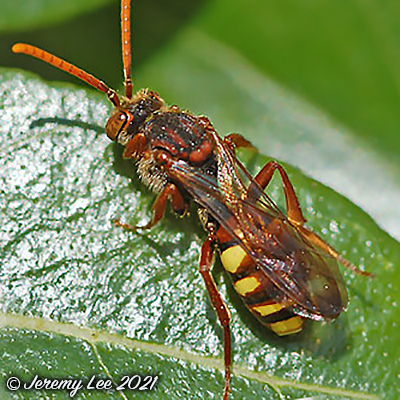
 |
|
Scientific Classifications explained » Amphibians » Ants » Aphids » Bees » Beetles » Birds » Bugs » Butterflies » Caterpillars » Damselflies » Dragonflies » Earwigs » Flies » Frog/Leafhoppers » Fungi » Galls » Grasshoppers » Harvestmen » Hoverflies » Lacewings » Ladybirds » Leaf Mines » Lichens » Mammals » Millipedes » Mosses » Moths » Sawflies » Slugs » Snails » Spiders » Trees & Shrubs » Wasps » Wild Flowers » Woodlice » Postboxes |
UK Nature > Bees > Nomada flava

Scientific Name: Nomada flava Common Name: Flavous Nomad Bee With over 850 species, the genus Nomada is one of the largest genera in the entire family Apidae, and the largest genus of cleptoparasitic cuckoo bees. They occur worldwide, and utilize many different types of bees as hosts, primarily the genus Andrena. As parasites, they lack a pollen-carrying scopa, and are often extraordinarily wasp-like in appearance with red, black, yellow colors prevailing, and with smoky (infuscated) wings or wing tips. Nomada flava has a body length of 10 - 12mm. Very similar in appearance to N. panzeri and N. ruficornis. Can be separated with a hand lens from N. ruficornis as it does not have a forked jaw. Females differ from N. panzeri in having yellow not silver hair on the thorax. Can be found along woodland edges and hedgerows plus brown field sites. Common and widespread over much of south-east England. Uncommon in Wales and further north. Not recorded from Scotland. |
|

https://www.uknature.co.uk is a website dedicated to showing the immense diversity of UK nature and wildlife. Our vast range of habitats, from lowland arable to snow covered mountains, from storm-ravaged coastlines to peaceful inland freshwater lakes and rivers, from dry, sandy heaths to deciduous and coniferous forests, all these habitats contribute to the abundance of UK nature. We have wild birds in huge numbers either residing or visiting our shores (597 recorded species as at July 2013) and we must also not forget the humble back garden with its grass lawns, flower beds filled with nectar rich flowers, shrubs and trees, all designed to attract huge numbers of insects such as bees, moths, butterflies and hoverflies; and finally the small ponds which provide safe havens for frogs, toads, newts and even slow worms and grass snakes. www.uknature.co.uk is the showcase for my personal passion, photographing uknature in all its glory. I sincerely hope you all enjoy the fruits of my labours. This site and all images contained therein is © Jeremy Lee 2004 - 2025. All Rights Reserved. Site design by Jeremy Lee. Site development & IT Support by Stuart Lee. |